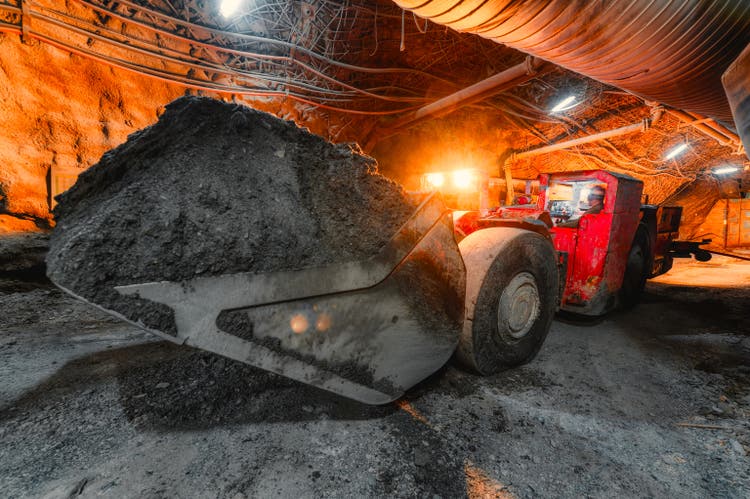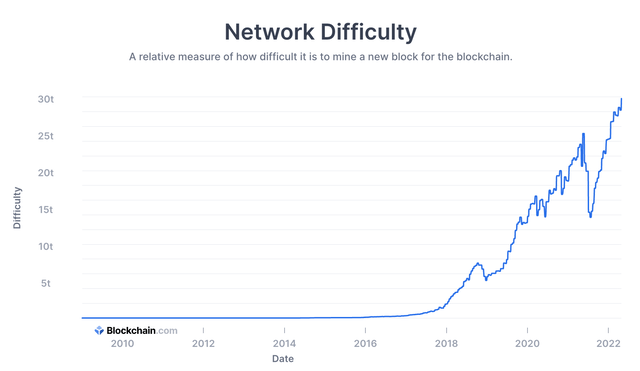Nordroden/iStock via Getty Images
Thesis
Exxon’s (NYSE:XOM) Bitcoin (BTC-USD) mining partnership with Crusoe will generate buzz and could improve the company’s image as it relates to environmental concerns, but it’s not likely to have much of a financial impact. On the other hand, if this partnership makes Bitcoin mining more profitable, it could have a big impact on Bitcoin’s security and potentially its price.
Bitcoin Mining 101
When I first heard the news that Exxon was getting involved in Bitcoin mining, my first question was how big of an impact this change could have, both on Bitcoin’s security and Exxon’s revenue.
For those who are not familiar with how Bitcoin mining works, mining is done to secure transactions on the Bitcoin network. The Bitcoin network could be attacked by anyone with more computing power than the “honest” miners, so the network becomes more secure when there are more miners using more computing power.
More specifically, it’s intended that a new block of transactions is added to the Bitcoin network every 10 minutes. It takes a certain amount of computing power to add a block, so the difficulty of solving for a block is adjusted every two weeks based on the current number of miners. When there is more mining activity, the difficulty is increased, making the network more secure.
The network difficulty has increased dramatically over time, although there have been times when it declined, such as when China recently banned Bitcoin mining:
Considering that Bitcoin’s price has also increased (more or less) exponentially over time, many people have noticed a correlation between network difficulty and Bitcoin price. It makes sense that when Bitcoin’s price rises, more miners can profitably exist, increasing the hash rate and network security. It also makes sense that when Bitcoin has more miners and is more secure, more people will feel comfortable investing in it, increasing demand and pushing Bitcoin’s price up. So, while it’s difficult to prove causation, I wouldn’t be surprised to see this correlation remain tight.
Flaring 101
It’s estimated that 142 billion cubic meters of natural gas are flared each year during the process of oil extraction. Because it’s difficult to capture, transport, process, and sell this natural gas, it’s simply flared, i.e., wasted. After all, there’s basically no demand for natural gas on isolated oil fields.
That is, there was no demand prior to Bitcoin. Instead of being flared, this gas can instead be put in a generator that powers Bitcoin miners placed near the oil field. Because the main input cost for Bitcoin mining is energy to power the computers used for mining, cheaper energy means more profitable Bitcoin mining. And since oil companies would otherwise throw it out, natural gas set for flaring is presumably dirt cheap.
There are multiple reasons why energy companies would want an alternative to flaring. For one, flaring is wasteful and bad for the environment. Also, North Dakota recently passed a law that gives energy companies a tax break for not flaring gas. And of course, selling gas that would otherwise be wasted for a profit is an easy business decision. For these reasons and more, oil companies have committed to stop routine flaring by 2030.
Selling the energy to Bitcoin miners seems like a great alternative to flaring. Eventually, the gas could be used to power other high-tech solutions like data centers as well.
Some Quick Math
142 billion cubic meters of natural gas is about 1510 terawatt hours of energy, assuming a conversion rate of 38.3 megajoules per cubic meter. It’s estimated that Bitcoin mining currently uses 150 terawatt hours per year. (For some perspective, the entire world used 24,000 terawatt hours of energy in 2019.)
Thus, assuming efficient usage, all Bitcoin mining could be powered with flared natural gas 10 times over. There’s a huge amount of cheap energy that’s currently going to waste.
If the process of efficiently using natural gas for Bitcoin mining can be figured out, it has quite a few implications:
- The network security of Bitcoin would meaningfully increase, which arguably correlates with an increase in Bitcoin’s price.
- Oil companies like Exxon that were previously wasting natural gas could instead sell it for more revenue and profit.
- The argument that Bitcoin – and to a lesser extent oil companies – are bad for the environment would lose some credibility.
- Current leading miners like Marathon Digital (MARA) and Riot (RIOT) could face increasing competition from miners using cheap natural gas, and become even more unprofitable (both are currently unprofitable).
Impact On Exxon’s Revenue
Although increased mining activity could increase Bitcoin’s price based on the price-difficulty correlation discussed previously, it’s difficult to quantify the exact impact. On the other hand, we can try to estimate the impact on Exxon’s revenue.
Right now, it looks like Exxon is simply selling the energy to miners through a partnership with privately held startup Crusoe. According to Crusoe, they pay Exxon for the gas and then Crusoe is responsible for harnessing it and turning it into energy.
After purchasing the gas, Crusoe can use it to mine Bitcoin, either directly or by partnering with other Bitcoin miners. What Crusoe chooses to do with the natural gas won’t make much of a difference to Exxon. Exxon is not mining Bitcoin directly and won’t have Bitcoin on its balance sheet. So, what matters to Exxon is what price they can sell the natural gas for and how much they can sell.
Crusoe indicated that they are purchasing the gas at a discount:
The gas purchase price is generally not comparable to traditional pipeline sales prices, but does establish a change of custody and arm’s length pricing for the gas.
As of February, natural gas was selling for about 27 cents per cubic meter, although the price has been volatile and varies quite a bit by country. In the unrealistic scenario where the 142 billion cubic meters of natural gas being flared throughout the world could be sold by Exxon at that price, it would generate $38B in revenue. For perspective, Exxon generated $317B of revenue in the last year, but only $26B in net income.
That sounds significant relative to income, but of course Exxon isn’t the only one flaring natural gas. It looks like the Exxon-Crusoe partnership currently utilizes about 6 million cubic meters of natural gas per year, which is just 0.004% of all the natural gas being flared.
Even at spot prices with 100% profit margin, the current partnership not even boosting Exxon’s income by 0.1%. If the pilot program is successful, it’s reasonable to expect that this number will increase over time.
However, there are some limits to how much gas can efficiently be used for mining. For example, it’s more difficult to mine in hotter climates like those of Exxon’s oil fields in west Texas. Also, it can be difficult to find the required hardware for mining amid semiconductor shortages.
So in the short term, this partnership has basically zero impact on Exxon’s financials. In the very long term, if we assume that Exxon accounts for 25% of all natural gas being flared, half of that very optimistically gets used for Bitcoin mining, and it’s sold at 75% of spot prices with 30% margin, it could add about $1B to Exxon’s bottom line. That’s a 4% increase in the current net income, so even in a very good long term scenario, selling more natural gas to Crusoe isn’t going to make much of a difference for Exxon’s financials.
However, in addition to a small boost in profits, this partnership could improve Exxon’s image with ESG investors and environmentalists, perhaps leading to better sentiment and multiple expansion. In addition to putting otherwise wasted energy to use, Crusoe’s mining systems are more efficient than flaring, combusting 99.89% of methane compared to 93% from flaring.
The discussion would get more complicated if Exxon mined Bitcoin directly, since that would expose them to more upside and downside in Bitcoin’s price. However, such a move seems unlikely considering Exxon’s conservative management and the fact that mining Bitcoin isn’t a very proven business model at this point.
Risks
Although selling natural gas to Crusoe for Bitcoin mining is a great (albeit small) short term win for Exxon, it could actually end up accelerating the renewable energy transition. Many sources of renewable energy have a problem very similar to flaring. During times of low demand or high productivity, excess energy is often generated by renewable sources but wasted because there’s no immediate demand and no efficient way to store it.
Crusoe plans to implement a similar solution for these renewable energy companies, where they will be able to use excess energy that would otherwise be wasted for Bitcoin mining. This solution will help renewable energy companies grow revenue faster and perhaps become more profitable, although if the impact on Exxon is any indication, the benefits may not be significant.
On the other hand, the impact of this partnership on Bitcoin looks mostly positive, as increased mining activity will lead to better network security and potentially higher Bitcoin prices. However, in the long term, partnerships like Exxon-Crusoe could cause mining to become more concentrated in a few companies that have access to cheap energy. Miners can choose which version of Bitcoin they secure, and while their choice should be governed by market forces, consolidation of miners could make Bitcoin less decentralized.
Conclusion
Exxon’s Bitcoin mining partnership with Crusoe makes for nice PR and could be a qualitative win when it comes to increasing demand for Exxon’s stock from ESG investors. However, it won’t make much of a difference in the bottom line and investors probably don’t need to consider this news when deciding whether to own Exxon. I am neutral on energy companies at this time, since the short term supply/demand picture still looks favorable but valuations are not looking nearly as attractive as a year ago.
However, this partnership looks to make Bitcoin mining more profitable and eco-friendly, which should lead to more overall mining activity and increase the security of the Bitcoin network. In the past, improved security has correlated with higher Bitcoin prices, so the continued success of this partnership could help to catalyze further price appreciation in Bitcoin.





